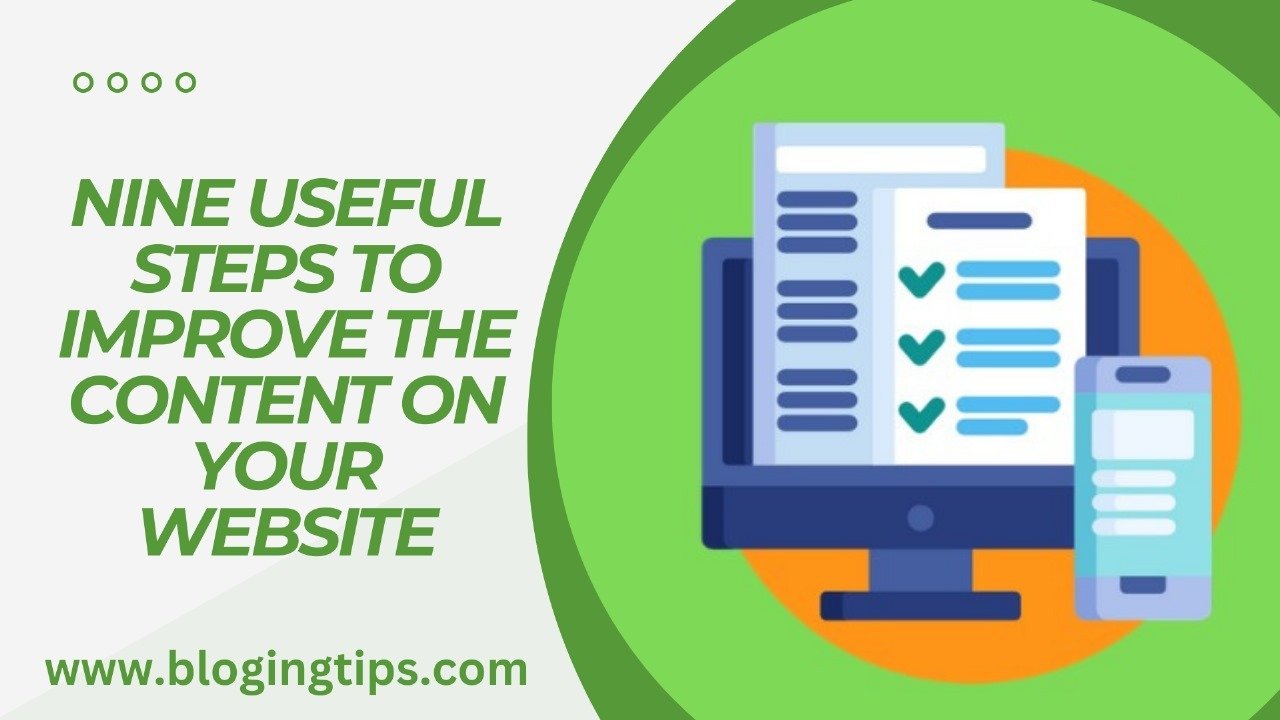Nine Useful Steps To Improve The Content On Your Website. Google has been a bit secretive about the factors that affect its rankings since its inception, however it is possible to be sure which factors rank at the list at the top. If I had my way, material would be the number. one ranking factor in Google’s algorithm.
This is because results from search engine payoff would not be possible without material to be ranked. It’s true that Google offers a variety of other indicators that show material is of paramount importance.
However, this is not just any material Quality material. Google will warrant their users receive only the perfect payoff.
Being aware how material is a significant indexing factor for ranking, it’s essential to regularly review you material to warrant you’re as high quality as it can be to warrant that you’re able to stand out in the results of the search outcome. Here, I’ll discuss nine methods to enhance your material.
- Do a content audit
- Perform keyword research
- Do some research on competitors
- Implement E-E-A-T
- Be sure that your material is always relevant
- Do some technical and on-page optimization
- Address duplicate content
- Do you try SEO siloing
- Review the Whole-SERP SEO Strategy
1. Do a Content Audit
If your website already has many material on your website, you should begin by conducting an material audit. This will provide you with an idea of where to start and provide directions on which pages you should improve.
Start by together a reputable SEO tool that gives you an overall view of all your websites (you can utilize SEOToolSet or SEOToolSet for this). accomplish this, however there are many other options).
Once you’ve got an extensive set of URLs you’ll break the websites into 3 buckets
- The first category includes websites which receive the highest rankings and traffic, for instance websites that rank up to position 10 in the results of a search. outcome.
- The other category is websites with the potential to gain better rankings and improve traffic like ones that start at position 11.
- The third bucket includes websites which perform poorly, but aren’t included in any of those categories.
Next, you should focus on improving the material in the first two categories.
2. Perform Keyword Research

When you are familiar with the pages you’re planning to optimize, take a look at the key words you would like to see on each page.
Find out which keywords have been allocated to what and then compare them to the searches bring in traffic.
Also, you can utilize our SEOToolSet to determine which keywords are driving traffic to your site. Additionally, you can use Google Search Console to see what search terms are driving clicks and impressions for your website’s Google results. payoff.
Check the keywords- are they still relevant to the material of the page and the intent of your visitors? Do you think the site should be optimized using other keywords?
3. Do some research on competitors
With a list of keywords for the pages and material you’re making changes to, it’s time to do some research on competitors.
If you don’t know what your competitors are doing in the results of a search outcome for every keyword (aka those that are ranked at the top of page one) you won’t have a an accurate idea of how you can optimize your material.
You can look at your competition using several different ways: 1.) Manual “old traditional” method, where you type in keywords into results of a search outcome and then start digging 2.) The automated method with tools to determine which websites have the highest rank for your search term.
The tools can grant you with an abundance of information quicker on the pages that rank highest along with their web pages. For instance when you use our SEOToolSet You could discover things such as:
- The ranking factors on the page
- The off-page ranking elements
- How often they are using the keyword you are targeting and in what context?
- Reading metrics for web pages
- Tips on how to improve your website based on market
- The performance of the website of your competition
Take a look at the free versions of these tools in our SEOToolSet to benefit get you to work:
The research on competitors can benefit you become the most perfect when compared to your competitors. When you are aware of how your competitors are optimizing their strategies your business, you will be able to do as well or even better than.
4. Implement E-E-A.T.
E-E A-T means knowledge, experience, authority and reliability. Google created this idea and it’s detailed in its Guidelines for Search Quality Rater.
This document was used initially internally to educate the search quality raters. These individuals assess the quality of results. results and, as such, Google can use this information to create an input loop to its algorithm.
In the end, the internal document was released in 2015, and Google released the complete version accessible to the general public. The document has been updated several times since the time, and anyone is able to access it.
This Search Quality Rater Guideline is an instructional guide for webmasters who want to know the way Google humans who rate quality evaluate high-quality material. It’s important to understand it and how you can apply it to your site.
Avoid falling in the mistake of believing it is applicable to the algorithm, it isn’t. However, it can serve as a general guidelines for creating better-quality websites.
In addition to your steps taken so far, apply the ideas from the Search Quality Rater Guidelines to review your most popular websites (and your site in general) to warrant they’re E-E A-T.
5. Make Sure Your Content Is Evergreen
It’s not unusual for old pages to rank well and draw to enough traffic. However, the majority of websites need to be updated in time. This doesn’t create an enjoyable user experience if a person lands on a website that has been dated.
This is the point where “evergreening” is the key. Evergreening is a way to ensure that material is able to stand against the test of time.
Practically speaking, that involves reviewing and editing the material to assure that it is based on current information. Perhaps the advice is out of date or the statistics and research that support your claims are up-to-date.
This is a crucial aspect to boost the website you’re creating. It is also, in fact it is accurate to do it according to a set schedule all through the year.
6. Do some on-page and technical Optimization
In this phase you’ll take the information you’ve collected from your research on competitors and begin applying it to your websites.
What factors on the web page optimization help your competitors? What technical aspects are assisting them?
You must assure that you are doing it as well. You could also outdo your competition through together an SEO checklist to determine what else is lacking in terms of optimising your material and websites.
7. Address Duplicate information
Duplicate material can be a hindrance to the SEO goals.
If you have two websites which are too alike, Google will choose the one it thinks is the most appropriate for a search, and filter the second out. It might not be the one you’re looking for.
Therefore, you must ensure that the pages that you’re upgrading aren’t duplicated on your site. “Duplication” may be as easy as using the same meta information.
However, you may have multiple copies of material on your website due to various other reasons. Here are some examples of how duplicate material can be created:
- Two versions of the site
- Separate mobile site
- Trailing slashes in URLs
- CMS issues
- Boilerplate material
- Pages with parameterization
- Product descriptions
- Material distribution
It is a given to stay clear of other forms of duplicate content as well including the spammy type. This occurs case when material on your website is like the material on a different website.
8. Try SEO Siloing

The place the material is displayed on your site could affect your site’s ranking. SEO siloing refers to an SEO method that organizes websites’ material by putting similar websites together.
How you structure a page on your site (whether it’s the way you link it to or the directory you place it in) will affect:
- Search engines’ crawling patterns through and interpret the page
- The relevance of the website is based on the payoff of the purpose of a search
It’s possible that you are still wondering how you can organize a website to boost search engine rankings. This is a simple explanation: One method by which search engines identify the most relevant websites for a particular search is through going through and analysing the pages they index, and then determining the desirable suitable.
Going a step beyond that, engines such as Google can analyze the general structure of the web pages they’re taking into consideration. This can benefit the search engine determine if a site is equipped with suitable support material to support the keyword used in search.
The search engine evaluates whether the website is a authority on the subject and, consequently, it is the accurate match for the query.
When you are making changes to your content the bigger picture of how your material is integrated into an organized website should not be ignored.
9. Consider a comprehensive SEO Strategy
Not to mention yet another “big picture” method to improve your material isn’t just about fixing your old pages, but rather making more specific new material. This is called the “whole-SERP” method.
A comprehensive SEO strategy analyzes the elements that are most prominent in your desired keywords and results. It analyzes the features that appear most prominently in your target keywords’ outcome and then develops new material according to the results. qualities can range from images and videos to prominent snippets of text and many more.
The objective is to produce and optimize material that Google considers to be the most relevant to a search. For some search terms, that could be videos, in addition to blue hyperlinks.
In that case it’s important to warrant that you’re creating videos to be used in those queries. This will give you a second chance to maximize the use of all the properties of search engines.



